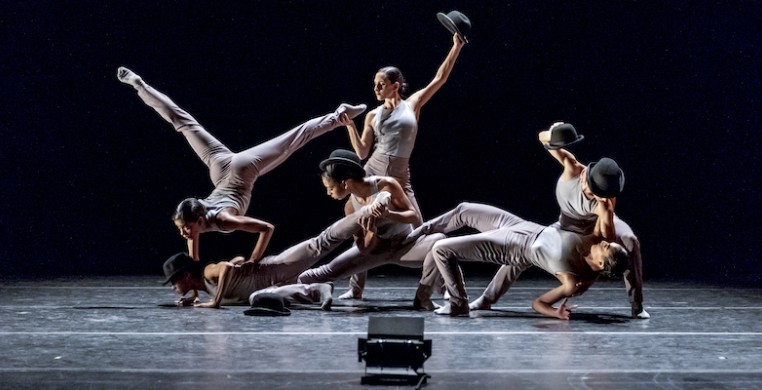Seven years have passed since Ballet Hispanico last performed in Chicago. The company toured to the Dance Center in 2012; it was the same weekend Luna Negra Dance Theater premiered “CARMEN.maquia” at the Harris Theater – a terrific project that, unknowingly, was the beginning of the end for Luna Negra, the company Eduardo Vilaro founded in 1999. Vilaro had since left Chicago to helm Ballet Hispanico, a company he once danced for under direction by founder Tina Ramirez. He's been artistic director and CEO since 2009.
So, there’s a tinge of sadness that inevitably comes from seeing what Luna Negra might have been, had Vilaro stayed, but the greater sense is one of pride in seeing the vision of contemporary concert dance infused with Latino cultures thrive. That’s how it felt, anyway, when Ballet Hispanico’s long-awaited return finally came Saturday with a one-night-only performance at McAninch Arts Center at the College of DuPage.
For any dance company whose mission centers around cultural heritage, it’s imperative that the programming juxtaposes universal themes and experiences with an effort to highlight individual voices. Works by three women choreographers spanning a range of cultural backgrounds beautifully captured this on Saturday, showing that Latina cultures cannot be umbrellaed. Yet, each piece, though clearly different, shares a certain type of struggle, contrasted by an infectious joie de vivre.
Opening the evening is Annabelle Lopez Ochoa’s “Sombrerísimo.” Surrealist paintings of men in bowler hats by Belgian artist Rene Magritte inspired “Sombrerísimo,” originally choreographed in 2013 for six men. Ochoa, who is half-Belgian and half-Colombian, used bowlers and the score, a melting pot of sounds bridging Latin American, Klezmer, Flamenco and Indian traditions, as an entree to a jovial exploration of culture. Props can, of course, be unwieldy, and it took a little time for the company to gel as this mixed-gender cast tumbled in and out of quirky tableaux. Ochoa channels Magritte’s witty humor with a few lighthearted gags, as when a tall, lanky man dons all six bowlers and falls to the floor, to be melodramatically dragged off by his petite partner. A sense of silliness overarching the piece keeps it from feeling virtuosic, a shame, since “Sombrerísimo” is filled with demanding phrasework and its fair share of acrobatics.
Michelle Mazanales’s “Con Brazos Abiertos” uses humor, too, mostly in the form of self-deprecating stereotypes about her background growing up Mexican-American in Texas. The piece begins with a cowboy song, and as the main curtain lifts, the dancers bring a distinct shift in mood as they file onstage in white underthings. Dandara Amorim Veiga is among them but stands still as the other dancers list through lighting designer Joshua Preston’s soft, pearly hues; Preston then further segregates Veiga with a box of light at center stage. It’s a strong symbol, interspersed by Cheech & Chong’s (intentionally) borderline offensive banter about Mexican-Americans. The message: that immigrants and children of immigrants often feel like they have one foot in each culture, not fully embraced by either, reinforced by a gorgeous pas de deux for Veiga and Lyvan Verdecia set to a cover of Radiohead’s “Creep.” But the overall mood of “Con Brazos Abriertos” is lighthearted and fun, these more serious moments counterbalanced with a fanastic sombrero dance, a long (too long) section of circular social dancing and a nod toward Mexican folk dance at the end, with the entire cast donning voluminous white skirts (designed by Diana Ruettiger) which, in motion, fill the entire stage with joyful exuberance.
Tania Perez-Salas closes the evening with “3. Catorce Dieciséis,” the choreographer’s homage to the number Pi. A playlist of Baroque tunes is an apt accompaniment for an intellectual dissection such as this, and on its face this is a sublime escapade which, appropriately, shows nothing of its mathematical inspiration. But Pi, the result of dividing the circumference of a circle by its diameter, is an infinite decimal, going on forever and ever. “3. Catorce Dieciséis,” by contrast, works in fits and starts. Numerous costume changes and looks onstage (by costume designer Amanda Gladu and lighting designer Bob Franklin) are all genuinely gorgeous, but separated by harsh black outs that come even before a phrase of dancing has finished. It’s as though Perez-Salas collected a bunch of ideas and strung them together; this feels a bit like a scrap book with no attention to transitions, or whether these things match or lead anywhere sensical.
Then again, Pi is an irrational number, too, so….



